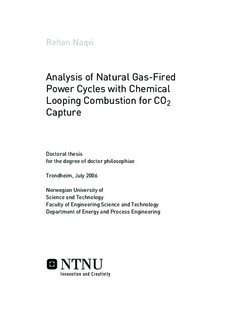| dc.contributor.author | Naqvi, Rehan | nb_NO |
| dc.date.accessioned | 2014-12-19T11:43:42Z | |
| dc.date.available | 2014-12-19T11:43:42Z | |
| dc.date.created | 2008-04-24 | nb_NO |
| dc.date.issued | 2006 | nb_NO |
| dc.identifier | 124197 | nb_NO |
| dc.identifier.isbn | 82-471-8038-3 | nb_NO |
| dc.identifier.uri | http://hdl.handle.net/11250/233369 | |
| dc.description.abstract | Chemical Looping Combustion (CLC) is a rather novel concept of hydrocarbon fuel energy conversion with inherent CO2 separation. In CLC, a solid oxygen carrier transports oxygen from air to the fuel; hence air and fuel remain in separate environments and the combustion exhaust mainly consists of CO2 and water vapour. CLC can be applied in a circulating fluidised bed reactor system. The main objectives of this work have been the sensitivity study of CLC-reactor system in combination with different oxygen carriers, design of different CLC-combined and CLC-steam cycle configurations, off-design behaviour analysis of CLC-combined cycles and investigation of the possibility to use conventional machinery in CLC-power plants. The main efforts have been directed towards cycle design including parameter optimisation and cycle performance including off-design operation of combined cycles. The comparison of CLC-cycles with conventional natural gas-fired combined cycles has been presented at all the stages of this work.
Energy and mass balance models for CLC based on the oxides of Fe, Cu and Ni in combination with inert supports of Al2O3 and NiAl2O4 have been developed. The results of study on different oxygen carriers in natural gas-based CLC indicate that NiO supported on NiAl2O4 is the most suitable oxygen carrier for achieving a conceivable reactor system. In order to be applicable in CLC-combined cycles, the reactor system and the oxygen carrier must stand a temperature of at least 1000°C and pressure of 10-26 bar.
Various configurations of natural gas-fired CLC-combined cycles with NiO/NiAl2O4 oxygen carrier have been studied in this work. The results show that different designs of CLC-combined cycles consisting of single reactor system operating up to 1200°C can achieve 50-52% net plant efficiency including CO2 compression to 110 bar. Different CLCcombined cycle configurations employing multi-CLC-reactors and reheat air turbine have also been analysed. CLC-combined cycle with two reactor systems and single reheat air turbine can achieve above 51% net plant efficiency at 1000°C oxidation temperature. At the same oxidation temperature, a cycle with three CLC-reactors and double reheat air turbine achieves about 52% net plant efficiency. At 1200°C oxidation temperature, single reheat cycle achieves above 53% net plant efficiency, while double reheat results in marginal efficiency improvement. All the CLC-combined cycles proposed in this work exhibit higher net plant efficiencies with close to 100% CO2 capture compared to a conventional combined cycle with 90% post-combustion CO2 capture. The off-design analysis of CLC-combined cycles shows that a CLC-combined cycle exhibits better relative net plant efficiency at partload, compared to conventional combined cycles with and without CO2 capture. However, the CLC-combined cycles need more advanced control strategies, especially if a CO2/H2Oturbine is included. The cycles demand advanced air flow control strategies during the startup, shut-down and at part-load below 60%.
Two designs of ultra-supercritical natural gas-fired CLC-steam cycles based on NiO/NiAl2O4 oxygen carrier have also been proposed and analysed in this work. The single reheat CLC-steam cycle can achieve net plant efficiency of about 43% while the double reheat CLC-steam cycle achieves 44% net plant efficiency with close to 100% CO2 capture.
This work suggests that CLC has a high potential for efficient power generation with CO2 capture. However, there are some technological barriers discussed in this thesis, which need to be overcome in order to successfully realise CLC application in power plants. | nb_NO |
| dc.language | eng | nb_NO |
| dc.publisher | Fakultet for ingeniørvitenskap og teknologi | nb_NO |
| dc.relation.ispartofseries | Doktoravhandlinger ved NTNU, 1503-8181; 2006:138 | nb_NO |
| dc.relation.haspart | Naqvi, Rehan; Bolland, Olav; Brandvoll, Øyvind; Helle, Kaare. Chemical looping compustion-analysis of natural gas field power cycles with inherent CO2 capture. Proceedings of ASME Turbo Expo: GT2004-53359, 2004. | nb_NO |
| dc.relation.haspart | Naqvi, Rehan; Wolf, Jens; Bolland, Olav. Part-load analysis of a chemical looping combustion (CLC) combined cycle with CO2 capture. Energy. 32(4): 360-370, 2007. | nb_NO |
| dc.relation.haspart | Naqvi, Rehan; Bolland, Olav. Multi-stage chemical looping combustion (CLC) for combined cycles with CO2 capture. International Journal of Greenhouse Gas Control. 1(1): 19-30, 2007. | nb_NO |
| dc.title | Analysis of Natural Gas-Fired Power Cycles with Chemical Looping Combustion for CO2 Capture | nb_NO |
| dc.type | Doctoral thesis | nb_NO |
| dc.contributor.department | Norges teknisk-naturvitenskapelige universitet, Fakultet for ingeniørvitenskap og teknologi, Institutt for energi- og prosessteknikk | nb_NO |
| dc.description.degree | dr.ing. | nb_NO |
| dc.description.degree | dr.ing. | en_GB |
